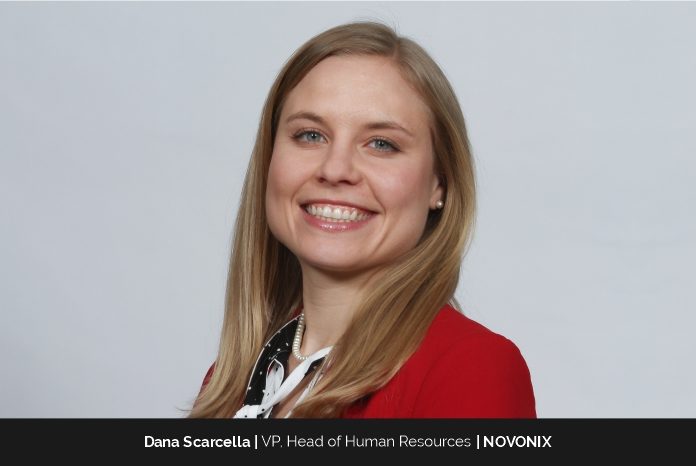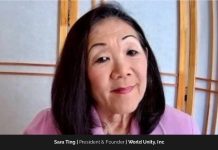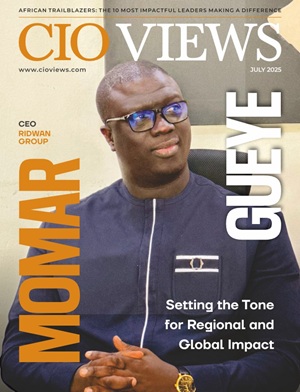
HR professionals are talent advisors. Dana Scarcella, VP, Head of Human Resources at NOVONIX, ensures her team members are embedded in the business so that they can understand the value proposition to the customer and how the company wins in the marketplace. She believes, “By understanding the daily challenges each department faces, we can offer vice for how to solve those challenges with our human capital.”
Dana observes several stagnant and out-of-date HR procedures, even at the most advanced companies. She is encouraging the members of her leadership team to break from tradition and attempt new things. She has incorporated ideas from the agile methodology so that the team can respond quickly to customer requests and shifting business conditions. She opines, “We implement pilots, get feedback quickly, and then adapt as needed. This requires us to be flexible and move very quickly.”
Professional Journey
Dana has a wide range of experience because she has worked for eight different organizations in seven different sectors. She has had the chance to work for several incredible companies throughout the course of her career and has incorporated many of the best practices she learned along the way.
Dana appreciates having a work-life balance and has made decisions that will allow her to have a family, raise her children in the way she sees fit, and yet have a fulfilling and vibrant career. She wants to lead by example in everything she does, in both her professional and personal life. She shares, “I could never have predicted my career path, but looking back, it’s clear how each job helped prepare me for the next one. It’s been a wild ride so far and I’m excited to see where the journey takes me!”
NOVONIX
NOVONIX is a manufacturer of battery materials and technology. Its mission is to develop innovative, sustainable technologies and high-performance materials to service the electric vehicle and energy storage industries. The battery industry has been growing and evolving at a rapid pace, and the demand for electric vehicles and grid-scale energy-storage systems is flourishing. The need for advanced materials and technologies that support long-life, high-performance battery applications has become increasingly more prevalent. Battery cell manufacturing has gained momentum in the United States, but the supply chain is lagging. NOVONIX anticipated this issue, and its Anode Materials division is onshoring it with plans to bring large volume production of high capacity, long-life synthetic graphite to the US to help meet the demand.
The management has very aggressive plans for growth at NOVONIX. Dana asserts, “We are in the early stages of our company’s lifecycle, with about 200 employees. We plan to grow our employee population by over 500% in the next 3 years! This is both exciting and challenging, as we are truly building the plane while we are flying it.” She is currently setting up the building blocks of the firm’s HR infrastructure, so that it can scale and grow.
At NOVONIX, Dana’s personal goal is to create the best company any team member has ever worked for. She says, “We are still early enough in our company’s lifecycle that we have a wonderful opportunity to start with a clean slate and build a company that we are all extremely proud of.” Dana feels fortunate that she joined a team that sees the potential of working toward something bigger than any one of them; they are all working toward a cleaner energy future.
Talent is a distinct advantage, in Dana’s opinion. She is on a mission to cultivate a fantastic workplace culture and an amazing employee experience in order to draw in and keep the best people. Although there is a lot of work to be done to establish the proper structures and governance, Dana is enthusiastic about the opportunities that lie ahead.
A Passion for Understanding People and Different Cultures
Dana excelled in math and science in school. In both subjects, there is a right and wrong response, and if one works hard enough, they will ultimately discover the correct answer. Human psychology is hardly the same – there is never one right answer on how to deal with people. Dana loves the uniqueness of each person, each team, each company, and each industry and is fascinated by different cultures around the world. These nuances of human psychology, along with the endless opportunity to contribute value to a business, was what attracted her to HR.
Dana attended college first in her family. She was raised by a single mother who held a unionized minimum-wage job. She couldn’t understand why there was conflict between management and the employees while she was growing up. She thought there had to be a better way. She decided to study Industrial Relations in college because she believed that human resource management was the key to a positive relationship between the employer and the employee. Dana is still adamantly of the opinion that direct, open, and honest communication between management and staff is the ideal kind of connection.
Defining Ideal Leadership
A leader must cope with uncertainty and ambiguity, get widespread feedback, and ultimately make difficult decisions. Making everyone happy is not a leader’s responsibility since it is just impractical. However, it is their duty to set a vision, articulate the rationale behind a choice, define expectations, communicate and inspire others in the process. A leader helps their team see the wider picture by having a thorough understanding of how the organization functions and how things are done.
A leader’s job is not just to give orders and delegate tasks. Dana says, “It’s not about telling people what to do, but rather to hold up the mirror and coach their team members so they can be the best version of themselves and bring their most creative problem-solving ideas.” Great leaders ask great questions. The most effective bosses Dana has had didn’t tell her what to do; instead, they asked great questions to get her to consider options.
Dana thinks that a leader’s job is to help others. The term “servant leadership” has gained popularity and has several interpretations. For her, it is getting rid of roadblocks so the group can function at its best. It entails recognizing those who go above and beyond by catching them doing the right thing and rewarding them for it.
Positive reinforcement has long been hailed as beneficial by psychologists, and she has personally found this to be true. She worked as a restaurant waitress while still in college. One day, everyone who was “in perfect uniform” received a $50 gift card from the general manager. Dana had adhered to a tight dress code, down to the color of her shoes, the way her sleeves had to be cuffed, and the color of her slacks. However, she was missing one item: a calculator. She says, “There was one thing I didn’t have on me which was a calculator, because there were 5 calculators at the restaurant, and we only needed them for approx. 5 minutes at the end of the shift when you had to ‘cash out.’ I was so disappointed that I didn’t win that gift card. But guess what? It changed my behavior. I never went to that restaurant ever again without a calculator and a perfect uniform.” She further adds that sticks don’t change behavior as well as carrots do, and carrots don’t incent behavior as much as a strong mission and purpose. She states that when people believe their work matters and they are working toward something bigger than themselves, then they are capable of achieving amazing things.
Focusing on Top Priorities
A career is made up of aspirations, capabilities, and sacrifice. Dana makes a concerted effort to know the trade-offs and make decisions ahead of time. Her goal isn’t to find balance, her goal is to be intentional. She shares, “Did I keep my commitments and focus on my biggest priorities, or did I fall to peer pressure and fall back on my old habits?” She believes that it takes courage to set boundaries and that success for her is being intentional about what she sets out to do.
One of the hardest lessons for Dana to learn was that she couldn’t give 100% to everything. Shortly after returning from maternity leave with her youngest son, she had to get out a pen and paper and break down her priorities into 3 tiers, for her personal life as well as her professional life. She recalls, “I decided that I would go out of my way and give 100% effort to Tier 1. I would do just enough, maybe 70-80% effort for Tier 2, and I would politely decline to participate in everything else that fell into Tier 3.” This means saying no to things she genuinely enjoys doing in order to give enough time to the most important things in her life.
Getting Perspective from the Toughest Challenges
“The toughest assignments are the ones you learn from the most.”
When profit margins are high and the economy is strong, it is easier to lead others. But when the economic climate is less rosy, things are considerably more challenging. It’s in these situations where Dana has found the most valuable lessons. She has experienced economic downturns, significant reductions in force, and difficult clients. In order to handle challenging situations and be the steadfast rock that workers can rely on, HR professionals need to have a thick skin.
Dana claims that one of the toughest challenges she had in her career was working for a company that had to make significant layoffs. The tension was palpable during the reduction in force, and one of the hardest days of her career was when the company had to announce the closure of an entire manufacturing plant. The lesson was that she needed to meet people where they were. She recalls, “I couldn’t sugar coat the situation or try to spin it into something positive. The reality was that hundreds of families had to worry about where their next paycheck was coming from, and to pretend that it wasn’t a hardship would have made the situation worse. So that taught me a lot about the value of good communication and having compassion.”
Dana has this quote hanging on her wall: “Smooth seas never made a skillful sailor.” It’s so true! It’s easy to get frustrated with the hardships thrown at us. Whenever that happens, she tries to stop and asks her higher power, “What is the lesson in this?” That helps give her perspective and gives her the energy to get through the challenge.
Success Occurs by Learning from Failures
Dana strives for continuous improvement and makes each iteration better than the last. She finds that success does not mean avoiding pitfalls, as roadblocks, obstacles, and setbacks are a part of life. Also, success is how one overcomes those obstacles. She always says, “We get paid to solve problems. We shouldn’t shy away from problems; our job is to proactively uncover them. We should actively seek out people who disagree with our ideas, as it allows for collaboration and a better end product in the long run. Once you define the obstacles, you can then create a plan to overcome them. Obstacles are the roadmap to success.” Dana doesn’t like to see challenges as setbacks, but rather as key learning opportunities. She considers that adversity may be uncomfortable, but discomfort is the currency of one’s dreams.
“If I inspire more than I criticize then that’s a good day.”
According to Dana, in order to be successful, people need to get good at failing. By that, she means, “We need to fail fast, through pilots and testing things out and getting feedback from the customer early and often. We also need to fail forward by learning from our mistakes and applying those lessons to future situations, so we do better next time.”
The Proudest Moments
Dana’s proudest moments are when people she manages or mentors get promoted and grow in their career. She feels like a proud parent when she sees someone she coached overcome an obstacle. She asserts, “I love to help people become the best version of themselves. The best recognition I’ve ever received is gratitude from a mentee saying that I helped them achieve a career goal.”
Advising to Build Support, Buy In, Trust, and Credibility
“Don’t be afraid to speak up and offer opinions and share perceptions if something’s not right,” says Dana. She finds that it’s better to ask questions and probe for understanding instead of making a declaration. Her advice for future generations is to “Recognize that your opinion is based on limited information and not all the facts – make it a goal to learn. Try to understand why they do what they do before trying to change it. Don’t go in guns blazing and declaring that things need to change. There is good reason why a process was set up a certain way. Know the history and the context and how they got here before you suggest a new idea.”
Dana also suggests that if one is emerging as a team leader, he or she should build a network and build their own tribe – both inside and outside of the organization. She shares, “The tribe members inside your organization will help you implement new ideas. Your network outside the org will help give you a fresh perspective and introduce you to new career opportunities.” She also suggests, “Be open to learning new things. Stay abreast of developments in your field by reading books, listening to podcasts, and attending industry conferences. Everyone you will ever meet knows something you don’t, so be prepared to listen and learn. And have some fun along the way!”




















